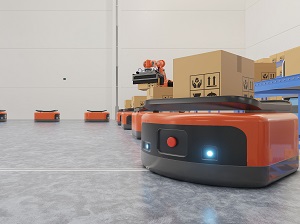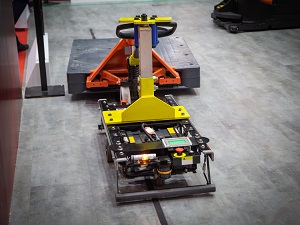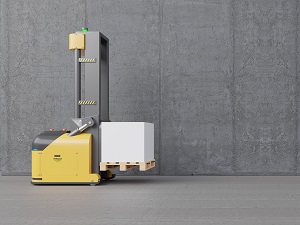Automated Guided Vehicles, commonly known as AGVs, are becoming increasingly common in manufacturing, warehousing, and industrial facilities. While AGVs are often considered safer than manually operated forklifts, significant hazards still exist, and worker awareness remains essential.

AGVs are portable, self-driving robots designed to transport loads from one location to another. Instead of human operators, they rely on sensors to follow their programmed paths and detect obstacles.
AGVs vs. Other Automated Industrial Vehicles
Industrial technology continues to evolve, and today’s facilities may use a mix of AGVs, Autonomous Mobile Robots (AMRs), and other automated equipment. Although similar, AGVs and AMRs have important differences:
- AGVs operate on fixed or programmed pathways and rely on sensors to detect obstacles. If something blocks their path, they simply stop.
- AMRs use more advanced navigation technology that allows them to adjust routes dynamically and operate more freely in changing environments.
Hybrid systems and new automation technologies may continue to develop, and terminology may evolve over time. For this article, the focus is specifically on Automated Guided Vehicles (AGVs).
Characteristics of AGVs
The AGVs covered in this article are:
- Self-driving
- Equipped with collision warning sensors
- Able to navigate a predetermined path using sensors or similar technology
- Capable of selecting destinations based on the load or task
- Not able to navigate around obstacles, but instead, they stop until the obstruction is removed

Types of AGVs Used in Industrial Settings
In addition to customized systems, four primary types of AGVs are typically used in manufacturing, logistics, and warehouse operations:
Tugger AGVs
Tugger AGVs are wheel-based vehicles designed to pull multiple non-powered carts or trailers behind them.
Forklift AGVs
Forklift AGVs are used to transport pallets and sometimes equipped with manual forklift capabilities. Some forklift AGVs have infrared sensors on the forks for pallet detection.
Unit Load AGVs
Unit Load AGVs are designed to transport single large items such as engines, coils of steel, or parts between machines.
Light Load AGVs
Light Load AGVs are smaller vehicles that carry loads under 500 pounds in tight or confined spaces—often transporting small parts, totes, or baskets.
Regulatory Requirements for AGVs
There are currently no specific OSHA standards written exclusively for the robotics industry. However, several established safety regulations and industry standards apply.
OSHA Regulations and the General Duty Clause
OSHA’s Powered Industrial Truck Standard 1910.178 covers forklifts, which share some characteristics with industrial AGVs, although the standard assumes human operation.
Employers must also follow the OSHA General Duty Clause.
OSHA 5(a)(1) Each employer shall furnish to each of his employees a workplace free from recognized hazards that are causing or are likely to cause death or serious physical harm.
This means employers must address known hazards associated with AGVs even if no specific OSHA standard exists.
ANSI/ITSDF B56.5 Safety Standard
The American National Standards Institute (ANSI) and the Industrial Truck Standards Development Foundation (ITSDF) developed ANSI/ITSDF B56.5, which provides safety requirements for Automated Guided Industrial Vehicles.
Employers should use this standard along with:
- Manufacturer guidance
- Industry best practices
- Facility-specific risk assessments

Training and Hazard Awareness
Comprehensive training is essential not only for AGV operators or system managers but also for any personnel who walk or work in areas where AGVs operate.
AGV Training should include:
- Understanding hazard zones and restricted areas
- Recognizing guidepaths and AGV travel lanes
- Identifying system alarms and signals
- Avoiding unsafe behaviors around automated equipment
AGVs can cause serious injury if workers enter hazardous areas or if the vehicle cannot stop in time.
ANSI/ITSDF B56.5-2019 4.3.2 Should an object suddenly appear in the path of the vehicle between the leading edge of the sensing field and the vehicle (i.e. an object falling from overhead or a pedestrian stepping into the path of a vehicle at the last instant), the vehicle shall initiate braking in accordance with brake system but may not be expected to stop in time to prevent contact with object.
Marking Restricted Areas and Guidepaths
Restricted areas of AGV operation must be clearly marked. In non-restricted areas, the floor space boundary required for the vehicle and its intended load and/or train shall be clearly marked, including the clearance necessary for turns and maneuvering.
Ensure blind corners have suitable audible and/or visual alarms to allow personnel to anticipate the approach of the AGV. Mirrors are also recommended in these locations. Signs, warning devices, and other safety devices should be used to alert and protect personnel from contact with the AGV, items moved by the vehicle, and any other equipment that interacts with the vehicle system.
Permanent aisles, roadways, and passageways utilized by the AGV should be clearly marked to warn personnel of potential AGV traffic and indicate that these vehicles have the right of way.

Definitions from ANSI/ITSDF B56.5-2019
- Guidepath – an intended path for the AGV
- Hazard Zone – an area of inadequate guidepath clearance with a max vehicle speed permitted of 1.2 m/s ≈ 2.6 mph
- Restricted area – an area of inadequate guidepath clearance with no escape route or an area of guidepath clearance which cannot be protected by object detection devices with a max vehicle speed permitted of 0.3 m/s ≈ 0.6 mph
- Very Narrow Aisle (VNA) Restricted Area – an area defined by fixed continuous racking and clearances of less than 0.5 m (19.7 inches) on both sides. Unauthorized personnel are prohibited from entering the area.
ANSI/ITSDF B56.5-2019 4.7.4 A minimum guidepath clearance of 19.7 inches shall be maintained on both sides of the guidepath or on one side of the guidepath if the guidepath clearance on the other side is 3.94 inches or less to a continuous closed fixed structure (e.g. a wall). All other areas shall be considered hazard zones or restricted areas and be clearly marked by signs, stripes, lights, or other designations.
Safe Practices for Personnel Working Near AGVs
When walking or working in areas where AGVs may be operating, personnel should:
- Slow down and look carefully when approaching corners or entering new aisles
- Listen for warning alarms
- Maintain a safe distance from moving AGVs
- Avoid distractions such as cell phones or loud headphones
- Never step into the guidepath of an approaching vehicle
- Be aware of load overhang or trailing carts

Vehicle Use, Maintenance, and Load Handling
Automatic Guided Vehicles can cause injury or damage if improperly used or maintained. OSHA states that many robot incidents occur during non-routine operating conditions, such as programming, maintenance, testing, setup, or adjustment. Never manually override vehicle safety devices.
ANSI/ITSDF B56.5-2019 4.2.1 No modifications or alterations to an automatic guided industrial vehicle that may affect the capacity, stability, or safe operation of the vehicle shall be made without the prior written approval of the system supplier.
All nameplates, caution labels, instruction markings and any other tags or decals on the AGV that have been provided by the manufacturer must remain in place and legible.
Only authorized personnel are permitted to maintain, repair, adjust, and inspect vehicle systems. Follow all manufacturer’s recommendations for maintenance and inspection. Maintain records of all maintenance activities.
AGVs should only handle stable or safely arranged loads. Consider how changes to the load, load position, coupling type, position, floor surface conditions and battery weight may affect rated capacity and safe operation. Changes in weather, surface conditions or applications may affect vehicle stopping distance so speed, the load, brake settings, or operation may need to be adjusted accordingly.
Automated Guided Vehicles can significantly increase efficiency and reduce manual material-handling risks, but only when workers understand the hazards and respect safe operating procedures. Proper training, clear markings, adherence to ANSI/ITSDF B56.5, and strict manufacturer compliance are essential for preventing injuries and keeping AGV systems safe.

.jpg)

